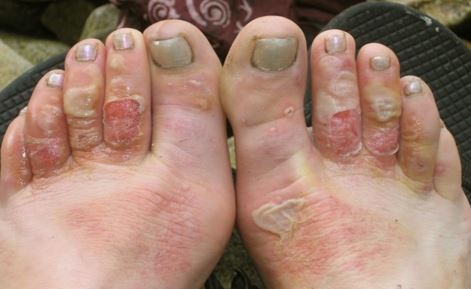Trench Foot
What is Trench Foot?
Trench foot which is also known as Non Freezing Cold Injury (NFCI) or Immersion Foot. It comes about when the feet are soaked in water that is unclean, cold, and dampened for a long period of time.

It can be utterly painful but can be treated and prevented though it might take three to six months to recover fully. Prevention is needed to avoid foot amputation and gangrene. The term “trench” is correlated with the trench soldiers way back in 1812 with the Army of Napoleon in the World War I.
It affected thousands of soldiers in waterlogged trenches who stayed and stood there for hours without their wet socks and boots removed. This will result with the feet getting numb and the skin turns red due to erythrosis or blue due to cyanosis because of the awful vascular supply.
There are much worse cases that may lead to swelling, blisters, sores, and fungal infections which is called topical ulcer. Although the amount of people with trench foot dropped dramatically, there are still people that have been influenced by the condition and some has severe cases as well.
What are the Symptoms of Trench Foot?
There are many symptoms of trench foot that may involve the toes or heels and sometimes the entire foot like the changes in color, swelling, and a foul smell because of the blood vessels, nerves, and skin that has been damaged. Other signs and symptoms may include:
- Numbness of the feet
- Stinging sensation
- A burning feeling
- Greyish color of the skin
- A pain that is sometimes severe
- Blotched and cold skin
- Heavy sensation
- Dryness of the foot
- Cracking and maceration of the skin
- Dying of tissues and skin

What Causes Trench Foot?
One of the main causes for trench is an environmental hygiene that is very poor. It is separated into three stages. The first which is the earliest stage is when the blood vessels constrict by the cold and drenched conditions inside the shoe resulting in a very small amount of oxygen getting to the cells of the foot.
The lack of oxygen supply will cause the foot to feel numb, cold, inflated, and delicate to touch. If it is warmed up right away, the tissue that has been damaged will commonly feel sensitive and red in color that lasts for hours or days.
The second stage is when the circulation is poor causing a certain damage to the foot cells. The foot swells more and the pain is constant. When the foot is re-warmed, blisters and ulcers form that will show the dead tissue under the skin. In this stage, gangrene might result.
The person suffers for weeks and drugs are being prescribed. The last stage is where the swelling finally dies down and the foot will begin to look normal once again. The person will experience itching, prickly feeling, and other complains that lasts for weeks or months.
How is Trench Foot Treated?
When the feet are exposed to wet or cold places, it should be air-dried afterwards and the socks should be dry as well as the shoes to avoid trench foot to develop. These treatments should be done:
- Clean the feet rigorously with an anti-fungal or anti-bacterial then dry it afterwards
- Do not use synthetic type of materials
- Use talc or baby powder for the feet in order for it not to be dampish
- Do not wear any socks when sleeping or even resting
- Do not wear socks repeatedly every day and use dry, clean ones
- Warm the feet for five minutes using heat packs for proper circulation
- Use drying agents
- For worst cases, injections and immersion should be done
If trench foot is not treated, it will lead to gangrene which will result to immersion in due course. However, if proper treatments are done, the person will recover completely but will experience some pain due to the discomfort in the feet. If the feet have wounds, it is more susceptible to infection.
For this to be avoided, the person should ask for medical assistance right away for daily checking of the symptoms of infections and whether it gets worse or not.
How to Prevent Trench Foot?
Before the trench foot even develops which can be very painful and may take long to recover fully, it is better to be prepared and prevent the condition from developing. These are the techniques:
- Wash and dry the feet every day to keep it clean
- Make sure that the shoes or boots fits well and not those that are too tight or too loose
- Use sock liners like Polypropylene which is designed to avoid feet moisture
- Use drying agents suggested by the physician to control an immoderate perspiration
- Use dry and clean socks but change it every day
- Apply Vaseline or talc powder to avoid moisture of the feet
- Use dry foot wears and alternating shoes every other day may also help to make sure that the shoes fully dries out
- Do not use vinyl and rubber or any other synthetic materials
References
- Trench Foot – CAUSES, SYMPTOMS, TREATMENT, PREVENTION at http://www.foot-pain-explored.com/trench-foot.html
- Trench foot – Pictures, Symptoms, Causes, Treatment, Cure at http://byebyedoctor.com/trench-foot/
- Trench Foot or Immersion Foot, How is trench foot prevented and treated? at http://emergency.cdc.gov/disasters/trenchfoot.asp
- Bullets, Boots and Bandages, presented by Saul David, BBC Four, February 2012, episode 1/3.
- Atenstaedt RL (2006). “Trench foot: the medical response in the first World War 1914-18”. Wilderness Environ Med 17 (4): 282–9.
- Régnier C (2004). “Etiological argument about the Trench Foot”. Hist Sci Med (in French) 38 (3): 315–32.
